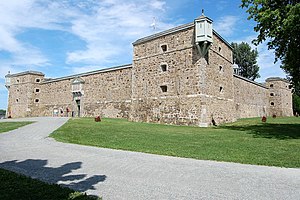Fort Chambly
| Fort Chambly | |
|---|---|
 |
|
| Type | Fort |
| Site information | |
| Controlled by | New France; Great Britain; Canada |
| Site history | |
| Built | 1675 |
| In use | 1675-1776 |
| Battles/wars |
Iroquois Wars — Seven Years' War — Invasion of Canada Campaign — American Revolution |
| Official name | Fort Chambly National Historic Site of Canada |
| Designated | 1920 |
Iroquois Wars — Seven Years' War — Invasion of Canada Campaign — American Revolution
Fort Chambly is a historic fort in La Vallée-du-Richelieu Regional County Municipality, Quebec. The fort is designated as a National Historic Site of Canada. Fort Richelieu was part of a series of five forts built along the Richelieu River. Fort Richelieu is at the mouth of the Richelieu River. Fort Chambly formerly known as Fort St. Louis at Chambly, Fort Sainte Thérèse, and Fort Saint-Jean at Saint-Jean-sur-Richelieu, are on the way. Fort Sainte Anne (Isle La Motte, Vermont) in Lake Champlain is near its source. The forts were built in order to protect travellers on the river from the Iroquois. The region is informally known as la Vallée-des-Forts.
Fort Chambly at the foot of the Chambly rapids on the Richelieu River in Quebec, Canada, was built by the French in 1711. It was the last of three forts to be built on the same site. The first — then called Fort Saint Louis — was constructed in 1665 by captain Jacques de Chambly, to protect New France from Iroquois attacks.
After minor repairs, the fort was burned by the Indians in 1702, but was reconstructed in 1702. By then it was already known as Fort Chambly. However, with the Great Peace of Montreal in 1701, the war between the French and Iroquois was over. Also at this time the War of the Spanish Succession broke out, and boiled over into the colonies of France and England. Thus, to defend against a more powerful European attack, including the threat of cannons, Governor Philippe de Rigaud Vaudreuil ordered that the fort be rebuilt in stone in 1709. The engineer responsible for the design and construction of the new fort was Josué Boisberthelot de Beaucours. He also oversaw major improvements carried out on the fort between 1718 and 1720, modifications he felt would greatly increase the fort's defenses.
...
Wikipedia
